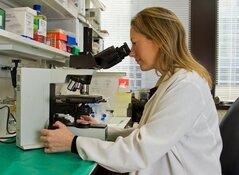The Life Sciences Report: Let's start with brilacidin. In August 2014, Cellceutix Corp. (CTIX:OTCMKTS) completed a 215-patient, Phase 2b study comparing three dosing regimens of brilacidin to daptomycin [Cubicin; Merck & Co. Inc. (MRK:NYSE)] in acute bacterial skin and skin structure infections (ABSSSI). In October 2014 you announced positive top-line efficacy. How did brilacidin perform against daptomycin?
Daniel Jorgensen: We compared very favorably to daptomycin. Those data have been publicly disclosed at academic conferences, including the 2015 European Congress of Clinical Microbiology and Infectious Diseases meeting this past April in Copenhagen, Denmark. The data are
The trial enrolled 215 subjects across four treatment arms: two single-dose and one three-day dosing regimen of brilacidin, and the fourth arm was seven days of once-daily daptomycin. Approximately two-thirds of these patients were infected with Staphylococcus aureus (including methicillin-resistant strains known as MRSA). The primary endpoint was clinical success, defined as reduction of at least 20% in area of ABSSSI lesion, relative to baseline, when observed 48–72 hours after the first dose of study drug, with no administration of rescue antibiotics. This is consistent with the 2013 Food and Drug Administration (FDA) guidance for ABSSSI studies and is the same primary endpoint used in recent approvals for ABSSSI drugs.
Clinical success rates were high across all brilacidin dosing groups, and similar to that of daptomycin. All brilacidin treatment regimens were well tolerated. There were six serious adverse events (SAE) reported across the study, none of which were considered related to brilacidin by the principal investigator. In previous studies, we had observed transient elevation of systolic blood pressure with higher doses of brilacidin. In this study, which used lower doses of brilacidin, elevated blood pressure (defined as a systolic blood pressure >160) was reported in just two (3.8%) of the subjects receiving 0.6mg/kg of brilacidin, and five (10%) of the subjects receiving daptomycin—a drug not known to affect blood pressure.
In other words, we feel we have found the right dose of brilacidin that is both safe and effective, and we are planning to test this dose in larger populations in two Phase 3 studies against an FDA-approved, first-line therapy for ABSSSI. The larger sample size in Phase 3 allows us to make statistical comparisons between our drug and the active comparator.
TLSR: Do you have to show superiority with a new antibiotic? I'm asking because the World Health Organization says we're in a post-antibiotic world due to antibiotic resistance, and we need more, especially novel, anti-infectives to combat bacteria that are bound to mutate and evolve into resistant subspecies.
Leo Ehrlich: In terms of getting our antibiotic approved, we must show non-inferiority in the trial to an FDA approved comparator drug. Non-inferiority is the statistical term that is used, and the criteria for non-inferiority are given in the FDA guidance for ABSSSI, which was published in 2013.
"We feel we have found the right dose of brilacidin that is both safe and effective."
Although the Phase 2b study was not large enough to be statistically powered, all three brilacidin dosing arms were as effective as daptomycin in treating ABSSSI. One reason we can say this is because the 95% confidence intervals around the clinical success rates for all four dosing arms were overlapping—this indicates a similar response. So, from the Phase 2b, there's no question we were similar to daptomycin. But, of course, we must do Phase 3 studies, and we must continue to make the case for why we believe brilacidin is a more beneficial drug than others on the market and in development today.
TLSR: Give us a of couple bullet points on the positive, or perhaps superior, aspects of brilacidin.
DJ: Although ABSSSI appears to be a crowded space, Cellceutix believes that brilacidin has several advantages over existing ABSSSI therapies, which may lead to a reduced burden of antibiotic resistance, for the following reasons:
First, brilacidin can be given as a single IV dose. At present, there is only one approved drug—and no generics—that can be given a single time for treating ABSSSI. This maximizes patient compliance, which removes noncompliance as a driver of antibiotic resistance.
Moreover, brilacidin's half-life is long enough to kill bacteria causing acute infection, but not too long. Some of the other ABSSSI drugs have very long half-lives, so the drug can reside in the body for prolonged periods, which could lead to the development of resistance.
Second, because brilacidin is the first in a new class of antibiotics, there is no expected cross-resistance. In contrast, all of the newly approved ABSSSI drugs have come from existing classes of antibiotics that have been marketed for years, if not decades. This can lead to cross resistance.
Third, brilacidin is effective against the stationary phase of bacteria. Most bactericidal antibiotics require bacteria to be in an "active growth phase" for rapid killing to occur. However, brilacidin is active against bacteria in both the rapid growth phase and the stationary phase, and it has been shown to disrupt biofilms. Killing bacteria in both phases decreases the opportunity for a "persistent bacteria" to evolve into a "resistant bacteria." This is yet another way that brilacidin could reduce the burden of resistance.
Fourth, brilacidin has immunomodulatory activity, including anti-inflammatory activity. This is not surprising, as brilacidin was created to mimic the key properties of our innate immune system. This is the immune system that protects our barrier surfaces, such as skin and mucous membranes. These immunomodulatory properties may help accelerate the healing of infections. We feel that an accelerated healing process can decrease the tendency of providers to give additional courses of antibiotics. It's these additional, often unnecessary, courses of antibiotics that can further promote the development of resistance.
"Brilacidin is active against bacteria in both the rapid growth phase and the stationary phase, and it has been shown to disrupt biofilms."
So, brilacidin is not simply an antibiotic. This combination of antibacterial, anti-inflammatory, and anti-biofilm properties can help reduce the burden of antibiotic resistance. Moreover, these properties could be harnessed in ways that address unmet medical needs. We hope to target biofilm-related infections, such as those involving catheters and prosthetic joints—a growing problem in our aging population. And we are developing brilacidin to treat inflammatory conditions on skin and mucous membranes.
Finally, brilacidin is a small molecule that can be scaled for economy because it is easy to produce from readily available raw materials. This is an additional advantage.
TLSR: Brilacidin performed well against MRSA, often a culprit in your disease indication, ABSSSI. Do you have any data specifically on biofilm infections, or do you consider all MRSA infections to be biofilms?
DJ: MRSA can form biofilms that are very hard to treat. These biofilms can be found in skin infection—notably post-traumatic and post-surgical wound infections. But we really get into biofilms when we talk about prosthetic or artificial joint infections and infections of foreign bodies, such as catheters and pacemaker wires. All of those infections could be caused by MRSA. Our drug is very good and very potent against MRSA. We have publicly disclosed that a major harma—we can't release the name for confidentiality and competitive reasons—is evaluating brilacidin for biofilm applications; this company recently placed a second, larger order of brilacidin for their studies.
TLSR: Are you concerned, from a regulatory sense, that the FDA, perhaps with input from the Centers for Disease Control and Prevention (CDC), would want to put brilacidin on the shelf for second- or third-line use so that it could be held out for very dire situations—possibly national emergencies—and to keep it out of the ecosystem in hope that resistant bugs won't develop too rapidly?
DJ: I don't think so. I think we may see the opposite scenario. For the reasons already stated, brilacidin is more likely than other antibiotics to reduce the overall burden of antibiotic resistance. Moreover, we have serial passage studies and mutation studies that indicate brilacidin resistance is unlikely to develop. This may have to do with its novel mechanism of action, which confers a fitness disadvantage for the development of resistance.
Because brilacidin can be given as a single dose, thereby guaranteeing patient compliance, and because it can be stored either at room temperature or in a refrigerator, it is the optimal drug to be used as first-line therapy on an outpatient basis in the emergency room or clinic. We have to remember that one of the best ways to minimize resistance is the rapid diagnosis and treatment of infections before the bacteria have a chance to become resistant. Treatment must be started quickly, and the entire course of therapy must be administered. We call this 100% compliance, and this is easy to achieve with a single dose regimen.
Noncompliance can occur when patients cease taking an antibiotic when they feel better, or when the infection looks to be clearing up. Noncompliance could be the result of not filling a prescription, or losing one's medication, or not tolerating a certain antibiotic. Regardless of the reason, noncompliance is more likely when multiple dose regimens are prescribed. Again, a single-dose regimen guarantees compliance, especially when given in the ER or clinic.
TLSR: I have spoken to antibiotic developers who admitted to sleepless nights fearing that their antibiotics might get labels from FDA that would limit use. My sense is that regulators now understand that hitting the bug hard the first time will minimize the chances of mutant strains. Do you see it that way?
DJ: Yes. Your point goes to understanding the underlying concept of the single dose. You kill the bacteria in a concentration-dependent manner. Hit the bugs hard, and hit them fast, and kill them off. As we know, dead bacteria can't mutate.
TLSR: This past summer, you had an end-of-Phase 2 meeting with the FDA. Brilacidin is the first host defense protein mimetic to get through a Phase 2 study, and it's not a peptide. Because it's a first mover in those categories, might the regulatory process be a little slower?
DJ: Yes. Because this is a brand-new class of antibiotic, the FDA has to be extra careful in its evaluation. I must add that the agency has been extremely helpful in guiding us through the drug development process.
LE: The good news is we have gone through the slow period to get brilacidin into Phase 3. We have already been through the hard work over several years, and jumped through the hoops to get to this point with this novel compound.
TLSR: Will interim looks at this study be more involved because of the first-mover status of this molecule?
DJ: The process of conducting an interim analysis and including a data monitoring committee is no different in this study versus other important studies. The fact that we're having an interim look is a good thing, especially for a brand-new class of compounds. We propose to do it after approximately 200 patients have been enrolled in the first of the two Phase 3 studies. We're set up in a way that we will not pause the study while we look at the interim data.
TLSR: I understand brilacidin gained FDA designation as a qualified infectious disease product (QIDP) in November 2014. That QIDP was created as a key element of the Generating Antibiotics Incentives Now (GAIN) Act, which was enacted in 2012 to incentivize development of new or novel anti-effectives that might have efficacy against serious or critical disease. What advantages does the QIDP give you? Does it expedite the process?
DJ: From a regulatory standpoint, it gives us an opportunity for expediting the normal FDA process, including the potential for priority review. We have to do an application for that, but basically it means that a drug could then be reviewed and approved in a shorter time than usual. That gets it on the market faster.
There is also a halo effect. Having a QIPD designation tells the academic community, tells patients, tells physicians and insurers and others, that you have a drug that can work against important pathogens that are resistant or becoming resistant, such as MRSA. In a way, you're building your market by having a QIPD designation.
TLSR: Back in March 2015, you got a commitment for a $30 million ($30M) direct investment from Chicago-based Aspire Capital Fund LLC. You could access that capital over a 36-month period. From what I can tell, you have hardly touched the cash as yet. How does this position you for trials and do you have other commitments for funding?
LE: At this time, we feel that with our cash on hand, the commitment from Aspire and our shelf registration, we have sufficient funding options to complete the Phase 3 ABSSSI trial, as well as continue our other clinical studies and move forward with additional laboratory work. Of course, everything is subject to market conditions. We're fully transparent and encourage investors to view our SEC filings for estimated budgets and more detailed information.
TLSR: Having a sophisticated investor like Aspire Capital gives other investors confidence because it validates your platform and your drug. But back in August of this year, you had some negative publicity from an anonymous writer in an online blog who was putting out inaccurate information, including erroneous scientific information. The piece also said something to the effect that Cellceutix was headquartered in an empty office building. Did Aspire Capital call to talk about the article?
LE: First and foremost, that article was criminal and we have had meetings with law enforcement about it. The justice may be slow, but we believe it is coming. Just the other week I was informed by someone active in the justice of another case that three "investment professionals" were just charged in a Manhattan Federal Court for a sophisticated scheme to defraud investors (http://www.justice.gov/usao-sdny/pr/three-investment-professionals-arrested-and-charged-manhattan-federal-court-connection). I hope that authorities continue to crack down on fraud that damages investors and the scientific community.
"Having a QIPD designation tells the academic community, patients, physicians and insurers that your drug can work against important pathogens that are resistant or becoming resistant."
That said, the article did not affect our relationship with Aspire Capital at all. Aspire is a large supporter of Cellceutix, and it believes in our science, or it would not have invested. It has visited our facility, our building, and it knows our offices. It knows our laboratories and scientists. It knows and understands the work we are doing.
We did see a panic by retail investors in that situation. As I said, we are very transparent with shareholders. We disclose more than most other companies through our press and SEC form releases.
TLSR: Investors would like to know upcoming milestones they might see in 2016.
LE: We have so many, between the Kevetrin, brilacidin and Prurisol trials. We have a very promising cancer drug in Kevetrin (thioureidobutyronitrile), a p53-targeting compound, which promotes apoptosis (cell death) in tumors. Kevetrin may actually have two mechanisms that induce apoptosis. We are now preparing for an advanced study of Kevetrin in ovarian cancer patients. We are looking into other cancers, but additional trials will depend on funds that we have available. In fact, we've just announced that we received an orphan drug designation from the FDA for Kevetrin for pancreatic cancer, and that the work underscoring this new designation was conducted by Cellceutix scientists in collaboration with pancreatic cancer specialists at a world-renowned clinic headquartered in Rochester, Minnesota, in preparation for a recently filed grant application.
We completed everything we set out to do in our Phase 1 trial with Kevetrin in solid tumors. The solid tumor trial is still open, and we are in discussions with the hospital and the trial's principal investigator. They have requested that we do certain scientific experiments. That's a great sign, because it shows the potential of this compound. To have an expanded Phase 1 when you've already met all the goals of the study, for scientific reasons and hopefully for better patient results, is a great thing. We want to characterize the compound more completely, and we want the physicians to understand it as well. This is unusual, and this does not happen frequently, and it's a real honor.
Meanwhile, we're moving forward with Kevetrin in advanced studies in ovarian cancer under an orphan drug designation from the FDA. We have an upcoming meeting with the FDA with respect to a Phase 2 trial and our goal is to get that trial started as soon as possible. Ovarian cancer is a huge unmet medical need, and there is very little out there for patients. Similar to the QIDP designation for brilacidin, the orphan drug designation for ovarian cancer has the possibility to expedite the development pathway.
TLSR: As far as your milestones for 2016 are concerned, you are moving ahead with your Phase 3 ABSSSI trial with brilacidin as well, correct?
LE: Yes, it is at the top of our list of goals for 2016. In addition to the ovarian cancer study with Kevetrin and the ABSSSI Phase 3 with brilacidin, we also plan on starting a brilacidin trial for ulcerative proctitis in March. That represents another use of this product, as an anti-inflammatory. We are also presently in a Phase 2 trial for oral mucositis with brilacidin under an FDA fast track designation, and we would hope to get interim data for that in the upcoming months.
We have a Phase 2 with our drug Prurisol (KM-133) in psoriasis ending shortly. We hope to have top-line data by early in May. Prurisol is a small molecule, orally bioavailable immune modulator. We feel a drug like this, which can be taken by mouth, gives us an advantage in a psoriasis market where injectable biologics are being used.
"We are now preparing for an advanced study of Kevetrin in ovarian cancer patients."
We are also working on a pediatric retinoblastoma program with Kevetrin, and are in talks with other companies that may want to combine the compound with either another compound, or a device, to better deliver the drug to these children's eyes. We have received an orphan drug designation and a pediatric rare disease designation from the FDA for Kevetrin for retinoblastoma.
We're also looking at brilacidin for otic diseases. We are working on formulating it in different concentrations, and then we will do the ototoxicity testing. We have gram-negative programs and antifungal programs. Of course, those are a little further behind. We have phenomenal compounds, and you will hear more about them in 2016.
TLSR: We have not talked much about Prurisol. Would you give a little background on that compound?
LE: Prurisol is a prodrug of a marketed drug called abacavir sulfate (Ziagen; GlaxoSmithKline [GSK:NYSE]), a nucleoside analog that has been phenomenal for treating HIV. It's a reverse transcriptase inhibitor, and was originally approved in the U.S. back in 1998. We have made changes to the molecule, but because of its similarity and long use in humans, it is eligible for the FDA's 505(b)(2) drug approval pathway, which is an abbreviated pathway for a drug already in use. This drug is actually the longest shot we have because the Phase 2 trial is the first treating psoriatic patients, and we will begin getting human data around the end of April. It's a double-blind study, so we don't know anything at this point. The path forward is quite logical, though. If the drug performs like abacavir, one might be inclined to think that there won't be activity against psoriasis. However, based on preclinical animal studies, for which we have published images of mouse models, we do expect Prurisol activity in this study. So the path is: Study the data including safety, determine which dose of the three did best, see time points when improvements occurred, and if warranted, proceed to further advanced clinical studies (i.e. Phase 2b/3 or Phase 3).
TLSR: Your market cap is just under $150M, and I found figures ranging between 2% and 9% institutional ownership of Cellceutix. Back on June 8, you sent out a press release saying you would not execute a reverse stock split to get your share price up to get your stock uplisted to the NASDAQ, and since then you have lost some market value. Are you rethinking that refusal?
LE: No. We're committed. We have so many great programs, and we believe that any one of them can propel the stock to multiple times its present value. Yes, right now it's limited as to who can buy the stock, and that's why we do want to uplist. But to do that, we have to focus on moving the science along, moving our trials along. Eventually the stock price will correct itself.
TLSR: On a regulatory basis, brilacidin would have to be thought of as your lead compound, would it not?
DJ: Using the simple definition of "lead compound," you could say our lead compound is brilacidin. But, that's only because it's closest to Phase 3, and because it provides a gateway to other anti-infective and anti-inflammatory indications—beyond ABSSSI and oral mucositis. However, all the other compounds we've discussed are very promising, and they could get accelerated very quickly.
LE: We're doing a cancer study currently and our goal is to get great results once we start the ovarian cancer trial with Kevetrin. That should progress relatively quickly. If we achieve that, things could move very fast from there. We are optimistic about brilacidin for ABSSSI and we are just as optimistic on Kevetrin, but they must pass the clinical trials. There is also the mid-stage trial of the oral formulation of brilacidin for oral mucositis, an indication that doesn't have any FDA-approved drugs, so there is great opportunity there for us. Even Prurisol for psoriasis is in the running. We have several FDA designations that can expedite the regulatory pathway, so I would not classify any of our compounds as a lead quite yet. All three are great compounds.
TLSR: It's a pleasure speaking with both of you. Thank you.
Leo Ehrlich, is a cofounder of Cellceutix and has served as CEO since November 2010. Ehrlich has more than 25 years of executive leadership experience in building and managing emerging growth companies. Ehrlich is a certified public accountant and received his BBA from Bernard Baruch College of the City University of New York.
Daniel Jorgensen, M.D., MPH, is an accomplished physician executive with more than 17 years of industry experience, including 10 years at Pfizer. Previously, he was the chief medical officer at PolyMedix Inc., where he worked on brilacidin, the first in a new class of antibiotics known as defensin-mimetics, and thereafter he continued his work as a consultant to Cellceutix, before joining Cellceutix as CMO. Jorgensen has a special interest in the development of single-dose and short-course antibiotics, particularly those that can reduce the burden of antimicrobial resistance. At Pfizer, he was the global clinical leader for single-dose azithromycin, and the development team leader for dalbavancin. He began his industry career at Pasteur Merieux Connaught, in the area of vaccine development. In these leadership roles, he has successfully ushered several products from early clinical development through full regulatory approval, both in the U.S. and abroad, playing a key role in NDA submissions and FDA advisory committee meetings. Jorgensen is a CDC-trained epidemiologist (EIS officer) and is the former Medical Officer for the State of Montana. He received his undergraduate degree from Yale, his MD from the University of Wisconsin, his MPH from the University of Washington, and his MBA from Yale. He is board-certified in pediatrics, infectious diseases and preventive medicine.
Read what other experts are saying about:
Want to read more Life Sciences Report interviews like this? Sign up for our free e-newsletter, and you'll learn when new articles have been published. To see recent interviews with industry analysts and commentators, visit our Streetwise Interviews page.
DISCLOSURE:
1) Dr. George S. Mack conducted this interview for Streetwise Reports LLC, publisher of The Gold Report, The Energy Report and The Life Sciences Report, and provides services to Streetwise Reports as an independent contractor. He owns, or his family owns, shares of the company mentioned in this interview: None.
2) Cellceutix Corp. is a sponsor of Streetwise Reports.
3) Leo Ehrlich and Daniel Jorgensen had final approval of the content and are wholly responsible for the validity of the statements. Opinions expressed are the opinions of Mr. Ehrlich and Dr. Jorgensen, and not of Streetwise Reports or its officers.
4) The interview does not constitute investment advice. Each reader is encouraged to consult with his or her individual financial professional and any action a reader takes as a result of information presented here is his or her own responsibility. By opening this page, each reader accepts and agrees to Streetwise Reports' terms of use and full legal disclaimer.
5) From time to time, Streetwise Reports LLC and its directors, officers, employees or members of their families, as well as persons interviewed for articles and interviews on the site, may have a long or short position in securities mentioned. Directors, officers, employees or members of their families are prohibited from making purchases and/or sales of those securities in the open market or otherwise during the up-to-four-week interval from the time of the interview until after it publishes.





































